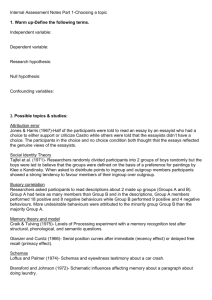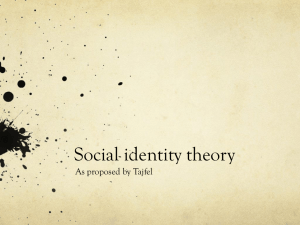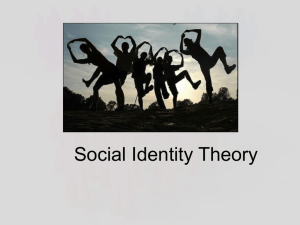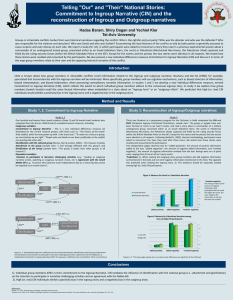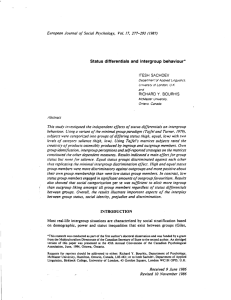Social Identity Theory
advertisement
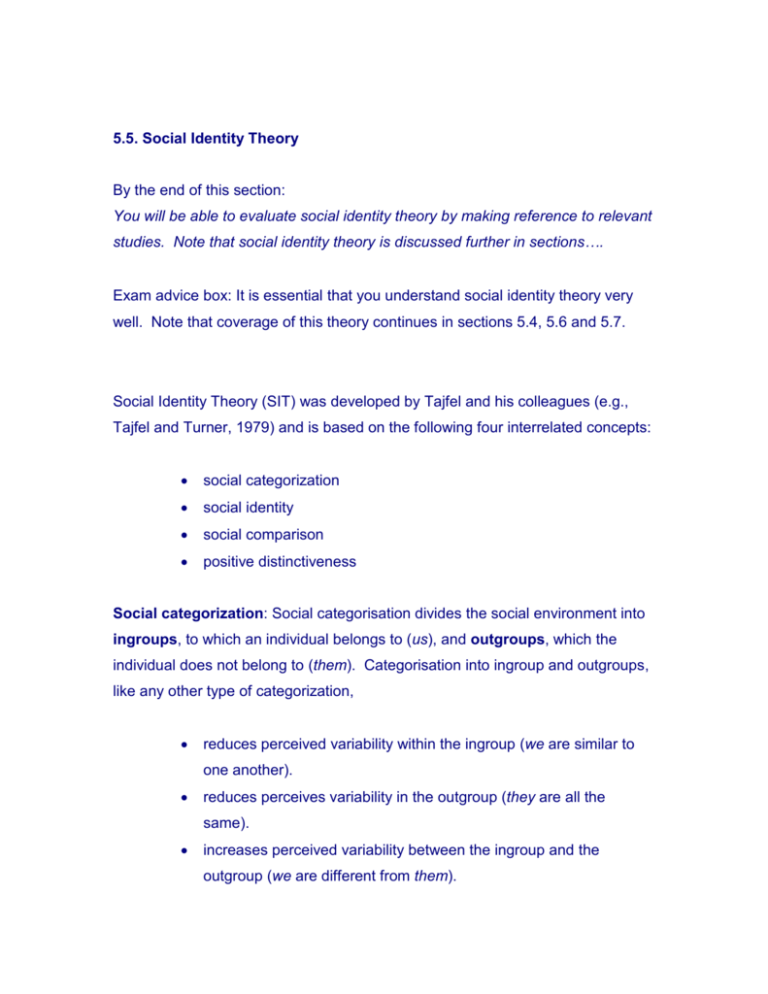
5.5. Social Identity Theory By the end of this section: You will be able to evaluate social identity theory by making reference to relevant studies. Note that social identity theory is discussed further in sections…. Exam advice box: It is essential that you understand social identity theory very well. Note that coverage of this theory continues in sections 5.4, 5.6 and 5.7. Social Identity Theory (SIT) was developed by Tajfel and his colleagues (e.g., Tajfel and Turner, 1979) and is based on the following four interrelated concepts: social categorization social identity social comparison positive distinctiveness Social categorization: Social categorisation divides the social environment into ingroups, to which an individual belongs to (us), and outgroups, which the individual does not belong to (them). Categorisation into ingroup and outgroups, like any other type of categorization, reduces perceived variability within the ingroup (we are similar to one another). reduces perceives variability in the outgroup (they are all the same). increases perceived variability between the ingroup and the outgroup (we are different from them). This exaggeration of group differences and intragroup similaries, result of social categorization, is called the category accentuation effect. Exercise: Give examples to illustrate some of the possible consequences of categorising your school’s population into different social groups? How about your school, compared to other schools? Social identity is that part of our self concept, which is based on knowledge of our membership of one or more social groups. Social identity is separate from personal identity, which is the part of the self-concept that derives from the way we perceive our personality traits and the personal relationships we have with other people (Turner, 1982). Personal identity is associated with interpersonal behaviours. Social identity, on the other hand, is related to intergroup behaviours. When I relate to you interpersonally, it is my individual characteristics that determine my behaviour. When, on the other hand, we relate towards one another as members of separate groups it will be our social identities that will determine our behaviours. Consider competition, for example: As Fiske (2008) notes, a pair of individuals can compete either as individuals or as members of rival teams. People can have several social and personal identities, reflecting the groups they identify with and the close relationships and personal characteristics that define them as individuals. Exercise: Are the behaviours that define the interaction between teachers and students interpersonal behaviours, intergroup behaviours, or both? Key fact: Interpersonal behavior is different to intergroup behaviour. Social Comparison and Positive Distinctiveness: According to SIT we strive for a positive self-concept. Our social identity contributes to how we feel about ourselves and, therefore, SIT claims people seek positive social identities to maintain and enhance their self-esteem. Positive social identities may result from the process of social comparison. We continuously compare our ingroups with relevant outgroups. This social comparison process is fuelled by our need for positive distinctiveness a term that is used to refer to the “motivation to show the superiority of one’s ingroup compared to an outgroup on valued dimensions” (Kessler and Mummendey, 2008, p.298). By establishing the superiority of our ingroup over relevant outgroups we make sure that our social identities, and therefore our self-esteem, are positive enough. Intergroup behaviours, based as mentioned above, on social identities exhibit several general characteristics including the following: Ethnocentrism: This can be defined as an ingroup-serving bias, in fact the group equivalent of the SSB discussed earlier. It involves the following: o Positive behaviours by ingroup members are attributed to dispositions. o Negative behaviours of ingroup members are attributed to situational factors. o Positive behaviours of by outgroup members are attributed to situational factors. o Negative behaviours by outgroup members are attributed to dispositions. So, if ‘we’ do good things it is because we are good and if we misbehave that is due to external factors. The reverse applies to ‘them’. Ingroup favouritism: This is when behaviour favours one’s ingroup over outgroups. Intergroup differentiation: The term refers to behaviour that emphasises differences between our ingroup and outgroups. Stereotypical thinking: Ingroupers and outgroupers are perceived according to relevant stereotypes in ways that are discussed further later. Conformity to ingroup norms. Acting in accordance to standards of behaviour defined by the ingroup. This is discussed further in the next chapter. Exercise: Use examples from everyday life to illustrate all of the terms outlined above. Studies Relevant to SIT: The Minimal Group Paradigm SIT has been supported by many experiments using the Minimal Group Paradigm introduced by Tajfel (e.g., Tajfel et al., 1971). This is a technique that defines ingroups and outgroups on arbitrary criteria like, for instance, by tossing a coin. Group members never meet or in any other way interact with one another. In fact, group members do not even know who else belongs to either their ingroup or the outgroup. That SIT is largely supported by such experiments is hardly surprising as the was initially developed by Tajfel and his colleagues to explain the findings from studies using the minimal group paradigm. An early such study can be found in Box 3. Box 3. The minimal group paradigm: Tajfel et al. (1971) Tajfel et al (1971) divided a number of British schoolboys into two groups. Although the experimenters allocated the participants randomly to the two groups, they were led to believe that the groups were defined on the basis of their preferences for paintings by Klee or Kandinsky. The boys, who worked individually, had to distribute money to ingroup and outgroup members. They were not allowed to give money to themselves. Tajfel et al were interested to see how the participants distributed the money to ingroup and outgroup members. The boys showed a strong tendency to favour members of their ingroup over members of the outgroup, thus manifesting ingroup favouritism. Interestingly, their strategies also provided evidence for SIT’s notion of positive distinctiveness. On many occasions the boys would sacrifice monetary gain for their ingroup in order to maximize the difference between their ingroup and outgroup. For example, when given the choice, participants gave an ingroup member 7 points and an outgroup member 1, rather than giving them both 13 points as they could have done. The categorisation into ingoup and outgroup members was even more arbitrary and meaningless in an experiment by Billig and Tajfel (1973). Participants, in their study, were explicitly told that they have been assigned to either group X or group Y completely randomly. The experimental task used was very similar to that used by Tajfel et al. (1971) apart from the fact that, instead of money, points were distributed to ingroup and outgroup members. The findings closely resembled the earlier findings by Tajfel et al (1971). What can we conclude from these studies? In accordance with SIT it seems that the mere categorisation, however arbitrary, of participants into ingroups and outgroups was sufficient to produce the following phenomena: identification with the ingroup ingroup favouritism outgroup discrimination positive distinctiveness In fact, there are several hundreds of studies, including a number of crosscultural studies, using the minimal group paradigm most supporting the major tenets of SIT (Hogg et al., 2008). The minimal group effect research, however, has also been critisised. Hogg et al. (2008) discuss such criticisms as follows. Could it be that the effects obtained are the result of the participants responding to demand characteristics. This is unlikely as the minimal group effect can be obtained even when the participants do not know they are being observed (Grieve and Hogg, 1999). Moreover, ingroup favouritism and outgroup discrimination have been repeatedly demonstrated in natural settings with real-life groups. Brown (1978), for example, carried out a field study of wage negotiations in a British aircraft engineering factory. He found that trade union representatives from one department sacrificed around £2 a week in order to increase their relative advantage over a competing outgroup to £1. This finding, clearly reminiscent of Tajfel et al.’s (1971) similar, is a clear demonstration of positive distinctiveness. The strength of the minimal group effect varies depending on a number of factors. Mummendey and Otten (1998) found that it is more powerful when participants distribute positive resources (money, points) and weaker, if at all present, with negative resources (e.g., punishment). The strength of the minimal group effect can also be reduced when participants have to justify their allocation of resources to ingroup and outgroup members (Dobbs and Crano, 12001). An Evaluation of SIT Some of SIT’s strengths are listed below: Starting with Tajfel’s pioneering minimal group studies, SIT has been supported by hundreds of relevant empirical studies. SIT demonstrated the crucial role of social categorisation in intergroup behaviour. SIT drew the distinction between personal identity and social identity and explored the ways our basic need to belong affects social interaction. It has contributed very significantly to the explanation of an impressive list of social psychological phenomena. In addition to what was discussed in this section, SIT has provided the theoretical basis for explanations in several other areas of social psychology like, for instance stereotypes and stereotyping (discussed in section 5.4), and explanations of conformity, groupthink and group polarisation (discussed in section 5.7) The original SIT theory has been expanding over the years and continues to generate a lot of research. Weaknesses of SIT include the following: The self self-esteem hypothesis, which figured extensively in the original statement, is no longer viewed as central to the SIT. Some studies have shown that the increase in self-esteem associated with outgroup discrimination is too short-lived to have long-lasting effects on how ingroup members view themselves (Rubin and Hewstone, 1998). One of the expressed aims of SIT was to favour situational explanations over dispositional ones. Yet, there is at least some evidence, suggesting that individual differences do affect SIT processes. Platow et al. (1990), for example, found that competitive participants showed greater ingroup favouritism than cooperative participants. Despite its shortcomings, SIT has stood the test of time and continues to make substantial contributions to our understanding of intergroup behaviour. As Hogg et al. (2008) observe, the simple idea underlying SIT, namely that social categorisation has extensive consequences, “has developed and evolved over the years to become perhaps the pre-eminent contemporary social psychological analysis of group processes, intergroup relations and the collective self “(p.407). Exam advice: When reading sections 5.4 and 5.7 keep a record of material (theoretical ideas and studies) relevant to SIT and use it, along with what is covered in the section to answer questions on the SIT.
